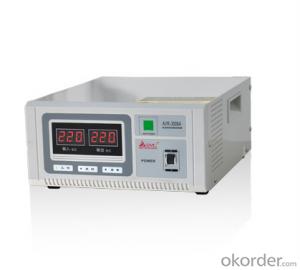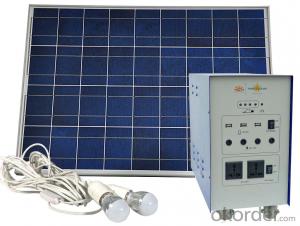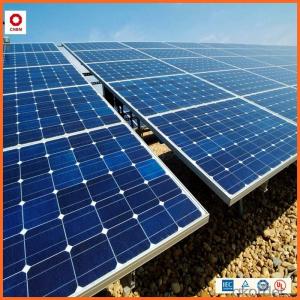Portable solar power system+500W Modify sine wave+34W Solar panels
- Loading Port:
- Shekou
- Payment Terms:
- TT OR LC
- Min Order Qty:
- 10 unit
- Supply Capability:
- 5000 unit/month
OKorder Service Pledge
OKorder Financial Service
You Might Also Like
Functions
1.The solar power system designed to provide DC power and AC power ,supply for lighting, mobile phone charging, run the
DC Fan and Radio, and TV ,computer etc.
2.Built-in PWM charge controller, real time display of battery capacity and load status.
3.Built-in maintenance-free Lead-acid battery.
4.With several output socket, can output voltage DC12V and USB DC5V at the same time.
5. Built-in DC to AC power inverter, can output AC220V/50HZ ,
6.Voice warning and together LED indicator shows the battery get low.
Technical parameters
| System voltage | 12V |
| Battery capacity | 20AH/12V |
| Max.charge current | 10A |
| Build-in solar panel Power | 38W, open circuit voltage:17.5V |
| Output voltage | DC output : DC socket: 12V/5A USB output: DC5V/800mA Cigar lighter: DC12V/10A Output AC : AC220V/50HZ |
| load power | DC Power: <120W (total power), AC Power:<500W |
| LVD (Low-voltage dis-cononect) | DC load LVD: 11.0V, AC load LVD: 10.0V |
| DC load re-connect voltage | 12.5V |
| HVD (High-voltage dis-connect) | 15.5V |
| Weight | 15KG |
| Dimension | 46*34*16 cm |
- Q:Are there any limitations to the amount of electricity a solar energy system can generate?
- Yes, there are limitations to the amount of electricity a solar energy system can generate. The primary limitation is the availability of sunlight. Solar panels require direct sunlight to generate electricity, so factors such as weather conditions, geographical location, and time of day can affect the amount of sunlight received. Cloudy or rainy days can significantly reduce the electricity output of a solar energy system. Another limitation is the physical space available for installing solar panels. The size and number of panels that can be installed depend on the available roof or ground space. Limited space can restrict the overall capacity of the system and, consequently, the amount of electricity it can generate. Additionally, the efficiency of solar panels is a determining factor. The efficiency of converting sunlight into electricity varies depending on the type and quality of solar panels used. Higher efficiency panels can generate more electricity than lower efficiency ones. Furthermore, solar energy systems are also subject to degradation over time. Solar panels experience a gradual decrease in efficiency as they age due to factors like exposure to sunlight, temperature fluctuations, and environmental conditions. This degradation can reduce the overall electricity generation capacity of the system. Finally, energy storage is a limitation. Solar energy systems generate electricity during the day, but the demand for electricity often remains constant throughout the day and night. Without an efficient energy storage system, excess electricity generated during the day is wasted if not used immediately. Therefore, the inability to store excess electricity limits the overall amount that can be generated by a solar energy system. In summary, while solar energy systems offer a sustainable and renewable source of electricity, there are limitations to the amount they can generate due to factors such as sunlight availability, physical space, panel efficiency, system degradation, and energy storage capabilities.
- Q:Can solar energy systems be used for powering electric vehicle delivery services?
- Yes, solar energy systems can be used to power electric vehicle delivery services. Solar panels can be installed on the rooftops of delivery service facilities or on charging stations to generate clean electricity. This renewable energy can then be used to charge the electric vehicles, reducing their reliance on the grid and minimizing their carbon footprint.
- Q:Can solar energy systems be used in areas with limited space on rooftops due to existing equipment or structures?
- Yes, solar energy systems can still be used in areas with limited space on rooftops due to existing equipment or structures. In such cases, alternative solutions can be employed to maximize the utilization of available space. One option is to install solar panels on ground-mounted systems instead of rooftops. These systems can be placed in open areas adjacent to buildings or even on unused land nearby. Additionally, solar canopies or awnings can be installed in parking lots or other open spaces to generate solar power. These structures can be designed to provide shade and shelter while simultaneously harnessing solar energy. Thus, even in areas with limited rooftop space, there are various creative options available to implement solar energy systems.
- Q:How do solar energy systems affect roof maintenance?
- Solar energy systems can actually help extend the lifespan of roofs and reduce the need for regular maintenance. This is because solar panels act as a protective layer, shielding the roof from various weather elements such as rain, snow, and UV rays. Additionally, solar panels can prevent debris from accumulating on the roof's surface, reducing the risk of damage or leaks. However, periodic inspection and cleaning of the panels may be required to ensure optimal performance and to address any potential issues.
- Q:Can solar energy systems be used for powering aquaculture systems?
- Aquaculture systems can indeed be powered by solar energy. Solar power is a sustainable and renewable source of energy that can be utilized to generate electricity. This electricity can then be employed to operate different components of aquaculture systems, including water pumps, aerators, heaters, and lighting. The utilization of solar energy in aquaculture systems presents several advantages. Firstly, it decreases dependence on finite traditional fossil fuels, which contribute to both environmental pollution and climate change. By adopting solar power, aquaculture systems can significantly decrease their carbon footprint and contribute to a cleaner and more environmentally friendly energy future. Secondly, solar energy is abundantly available in numerous regions worldwide. By harnessing the sun's power, aquaculture systems can function independently of the electricity grid, benefiting remote areas that can now engage in sustainable aquaculture practices. Thirdly, solar energy systems offer long-term cost savings. Although the initial setup and installation costs may be higher compared to conventional energy sources, solar energy systems have significantly lower operational expenses. Once the system is installed, solar power is essentially free, and maintenance costs are minimal. This can result in substantial savings over time, making solar-powered aquaculture systems a financially viable choice. Lastly, solar energy systems can be integrated with other renewable energy technologies, such as battery storage systems. This enables surplus solar energy to be stored and utilized during periods of low sunlight, ensuring a consistent and reliable power supply for aquaculture systems. In conclusion, solar energy systems are an effective means of powering aquaculture systems, offering numerous benefits including environmental sustainability, energy independence, cost savings, and integration with other renewable energy technologies.
- Q:How do solar energy systems impact the aesthetics of a building?
- Solar energy systems can have both positive and negative impacts on the aesthetics of a building. On the positive side, solar panels can be designed to blend in with the architecture and become an attractive addition to the building. They can enhance the modern and eco-friendly image of a structure, showcasing the owner's commitment to sustainability. However, some people may find solar panels visually unappealing or believe they disrupt the traditional aesthetics of a building. It ultimately depends on the design and integration of the solar energy system, as well as personal preferences and the surrounding environment.
- Q:Can a solar energy system be used in areas with high levels of pollution from industrial activities?
- Yes, a solar energy system can still be used in areas with high levels of pollution from industrial activities. While pollution can reduce the efficiency of solar panels over time due to dust and particulate matter accumulating on the surface, regular cleaning and maintenance can mitigate these effects. Additionally, advancements in solar technology have made panels more resilient to pollution, allowing them to still generate electricity even in polluted environments. Nonetheless, it is important to note that reducing pollution and transitioning to cleaner sources of energy is crucial for long-term sustainability and environmental health.
- Q:Can a solar energy system be installed on a roof?
- Yes, a solar energy system can be installed on a roof. In fact, rooftop solar installations are quite common and popular. By installing solar panels on a roof, homeowners and businesses can harness the power of the sun to generate clean and renewable energy. This not only helps reduce electricity bills but also reduces reliance on fossil fuels and contributes to a more sustainable future. Rooftop solar installations are typically designed to maximize sunlight exposure and can be installed on various types of roofs, including flat roofs and sloped roofs. With advancements in technology and the availability of various mounting options, solar panels can be securely and efficiently installed on roofs of residential and commercial buildings.
- Q:How do solar energy systems affect energy bills?
- Solar energy systems can have a significant impact on energy bills by reducing or even eliminating the need to purchase electricity from the grid. These systems generate electricity from sunlight, which can be used to power homes or businesses. When excess electricity is produced, it can be fed back into the grid, earning credits or reducing the overall bill. As a result, solar energy systems can greatly reduce energy bills over time, providing long-term cost savings and potentially even making households or businesses energy independent.
- Q:What is the impact of temperature fluctuations on the performance of solar panels?
- The performance of solar panels can be significantly affected by temperature fluctuations. When exposed to high temperatures, solar panels tend to become less efficient, resulting in a decrease in power output. This is mainly because the materials used in the panels, such as silicon-based photovoltaic cells, are sensitive to changes in temperature. One of the primary consequences of high temperatures is an increase in resistance within the solar panels. This higher resistance leads to a loss of electrical current flow, reducing the overall efficiency of the panels. Additionally, the semiconductor material in the panels can expand under high temperatures, potentially causing microcracks or other damage to the structure. This further diminishes the efficiency and lifespan of the panels. Conversely, extremely cold temperatures can also have a negative impact on the performance of solar panels. In cold conditions, the conductivity of the materials used in the panels decreases, resulting in higher resistive losses. Moreover, the accumulation of snow or ice on the panel surface can impede sunlight absorption, further decreasing power output. To counteract the effects of temperature fluctuations, solar panels are often equipped with thermal management systems. These systems help dissipate excess heat and maintain an optimal operating temperature range for the panels. Common techniques include the use of cooling fluids, heat sinks, or ventilation systems. By controlling the temperature, the performance and longevity of solar panels can be enhanced. It is important to note that although temperature fluctuations can impact the efficiency of solar panels, they still remain a viable and sustainable source of energy. Advances in solar technology, such as the development of more temperature-resistant materials and improved thermal management systems, continue to improve the performance and reliability of solar panels in different climate conditions.
1. Manufacturer Overview |
|
|---|---|
| Location | |
| Year Established | |
| Annual Output Value | |
| Main Markets | |
| Company Certifications | |
2. Manufacturer Certificates |
|
|---|---|
| a) Certification Name | |
| Range | |
| Reference | |
| Validity Period | |
3. Manufacturer Capability |
|
|---|---|
| a)Trade Capacity | |
| Nearest Port | |
| Export Percentage | |
| No.of Employees in Trade Department | |
| Language Spoken: | |
| b)Factory Information | |
| Factory Size: | |
| No. of Production Lines | |
| Contract Manufacturing | |
| Product Price Range | |
Send your message to us
Portable solar power system+500W Modify sine wave+34W Solar panels
- Loading Port:
- Shekou
- Payment Terms:
- TT OR LC
- Min Order Qty:
- 10 unit
- Supply Capability:
- 5000 unit/month
OKorder Service Pledge
OKorder Financial Service
Similar products
New products
Hot products
Hot Searches
Related keywords





























